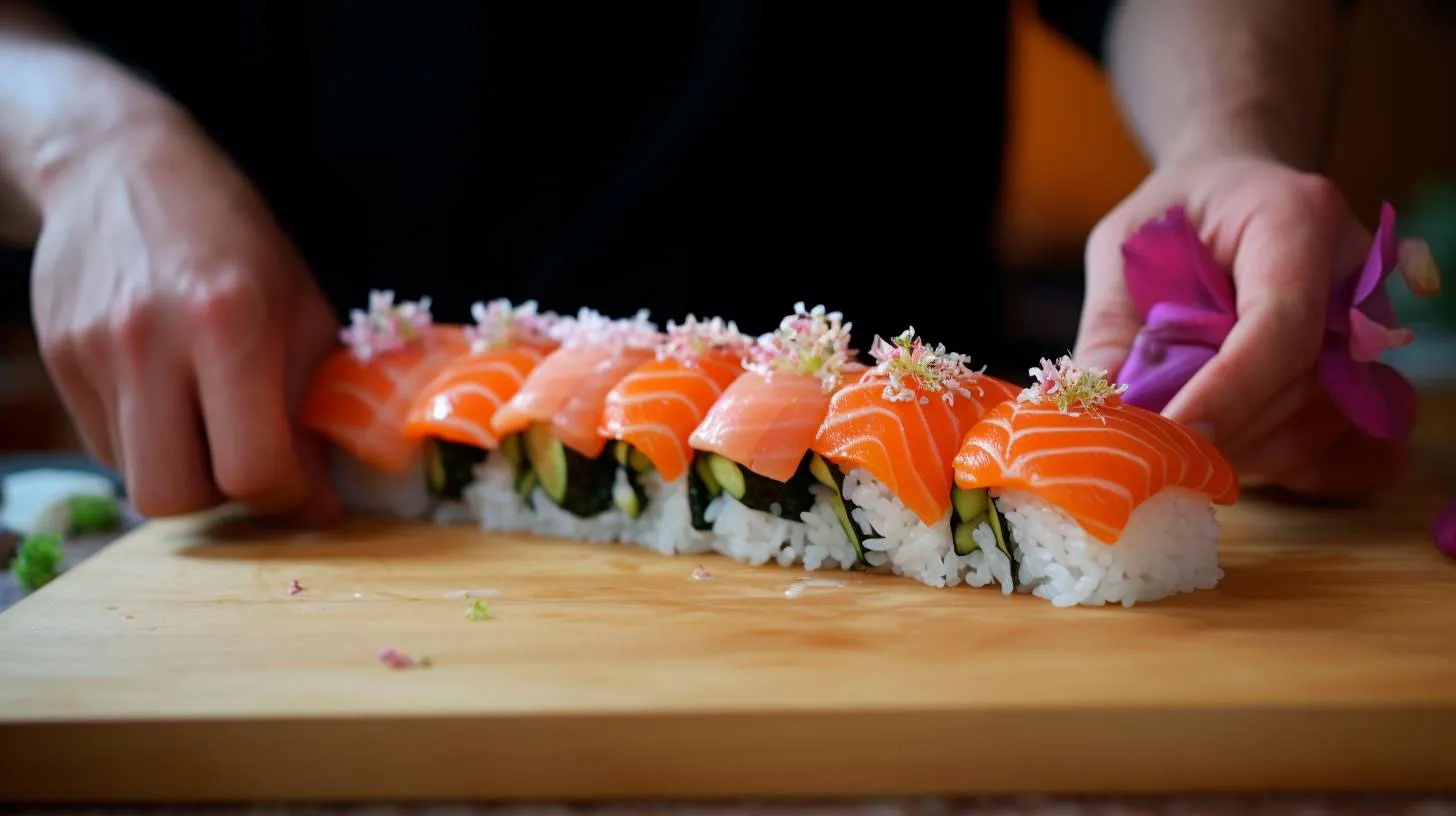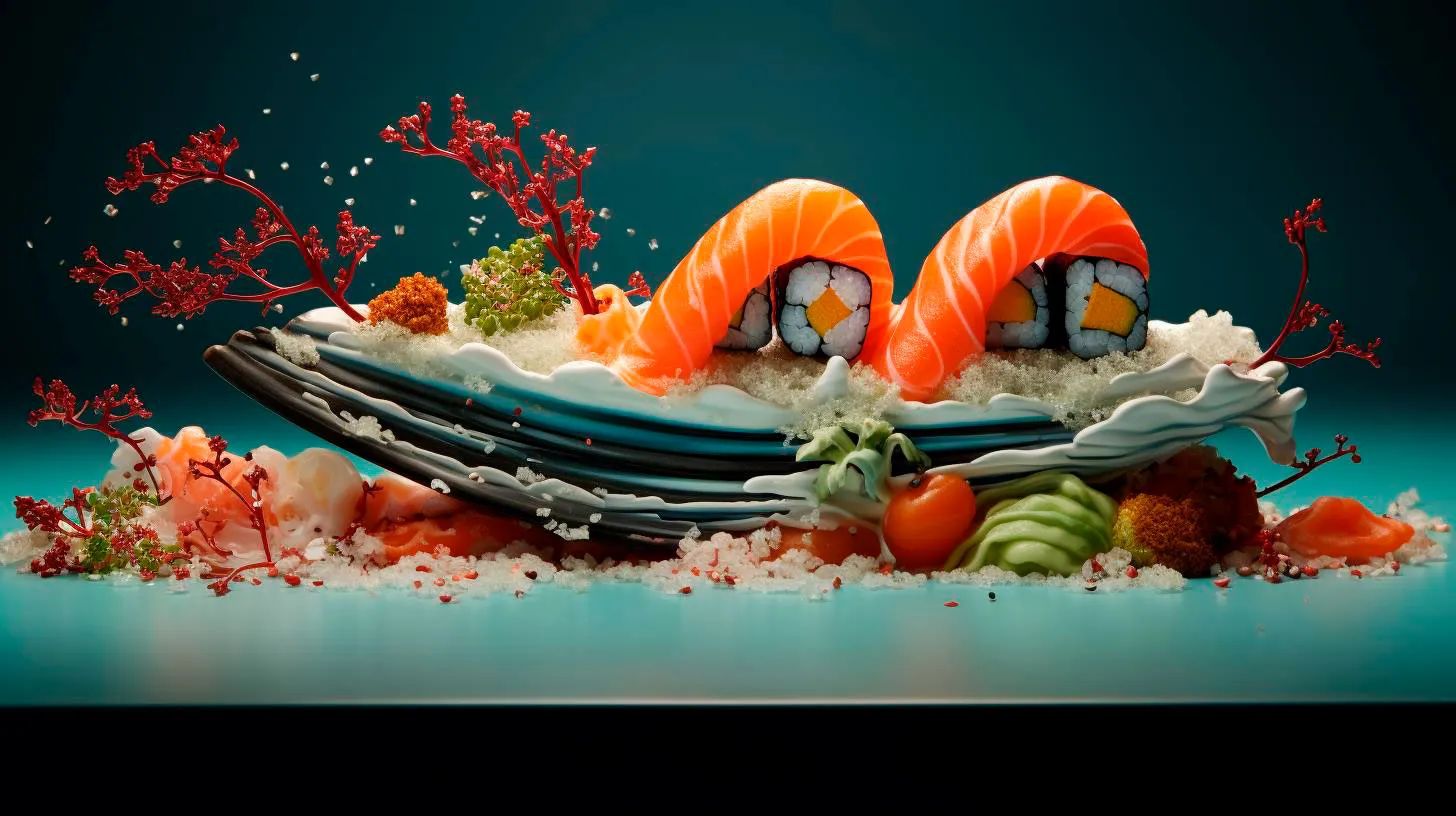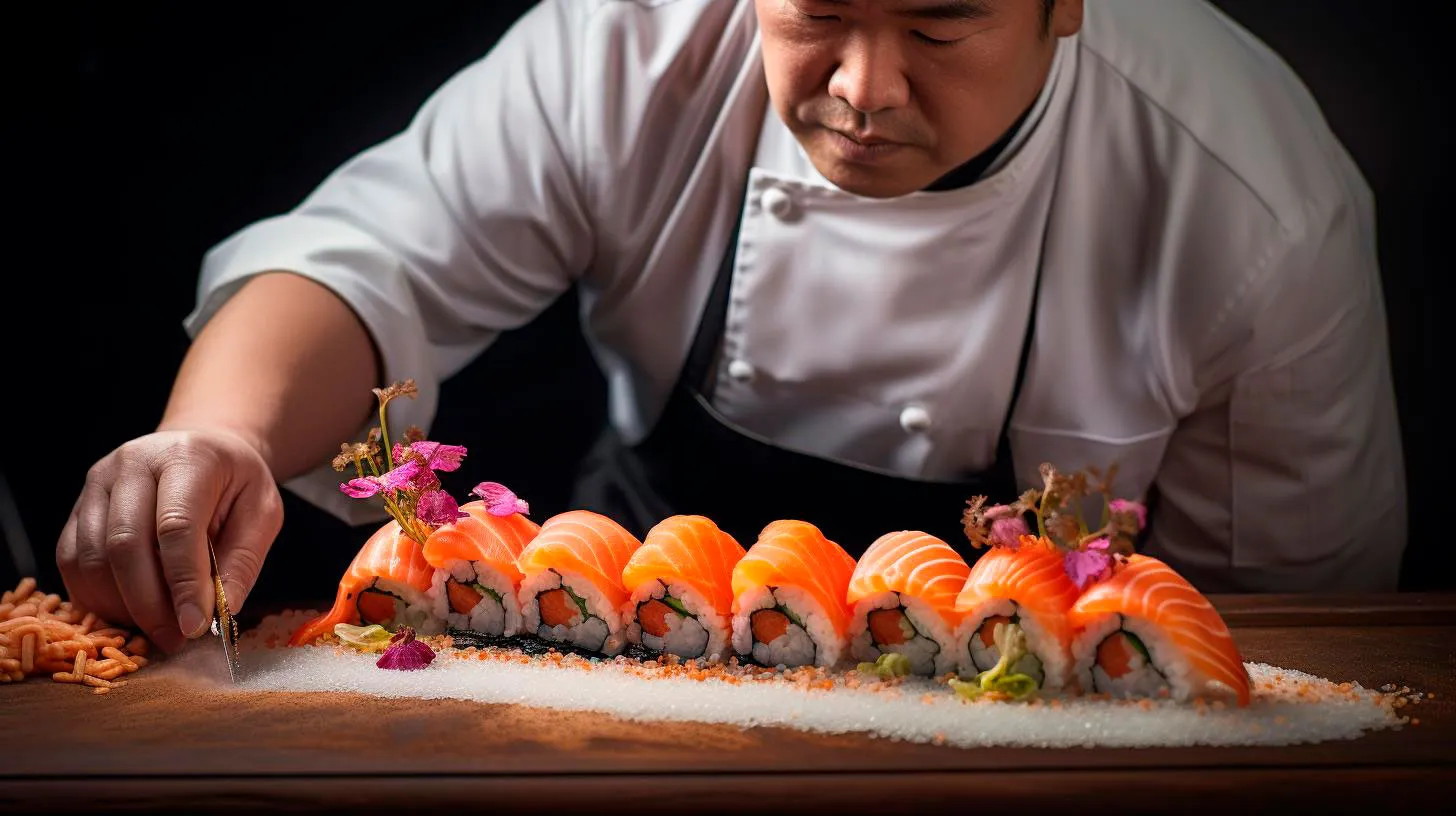Preserving Ancient Techniques: Okinawa Traditional Sushi Making
One such region is Okinawa, which has its own unique approach to sushi making, employing ancient techniques that have been passed down through generations. In this blog article, we will dive into the fascinating world of Okinawan traditional sushi making, exploring its rich history, techniques, and the importance of preserving this culinary heritage.
A Brief History of Okinawa Traditional Sushi Making
Okinawa, a beautiful archipelago situated south of mainland Japan, has a vibrant culinary scene deeply rooted in its rich history and cultural heritage. Traditional Okinawan sushi, known as “Okinawa-zushi,” differs from the more well-known Edo-style sushi found in other parts of Japan. While Edo-style sushi focuses on bite-sized pieces of fish over vinegared rice, Okinawa-zushi showcases larger rectangular pieces of sushi rice topped with various ingredients.
The origins of Okinawa-zushi can be traced back to the Ryukyu Kingdom era (15th to 19th century), when trade routes exposed Okinawa to various culinary influences, including China and Southeast Asia. Okinawa-zushi adapted these influences, blending them with local ingredients and techniques, resulting in a unique sushi style that appealed to the local population.
However, with the introduction of Western cuisine during the post-World War II American occupation, Okinawa-zushi faced the risk of being overshadowed by new food trends and influences. This posed a significant challenge to preserving the traditional techniques and flavors of Okinawa-zushi.
Preserving Okinawa Traditional Sushi Making
In recent years, efforts have been made to preserve Okinawa’s traditional sushi-making techniques and culture. Local sushi artisans and organizations are working tirelessly to ensure that the ancient methods and ingredients are not lost to time. These preservation efforts include:
- Apprenticeship Programs: Experienced sushi masters pass down their skills to younger generations through apprenticeship programs. These programs provide hands-on training and guidance, allowing the art of making Okinawa-zushi to be perpetuated.
- Documentation and Research: Scholars and researchers are documenting the techniques, ingredients, and history of Okinawa-zushi to ensure its preservation for future generations. This comprehensive knowledge ensures that the essence of this unique style of sushi is not lost or diluted.
- Promotion and Education: Local organizations and culinary enthusiasts are actively promoting Okinawa-zushi through workshops, cooking classes, and food festivals. These initiatives aim to generate awareness and appreciation for the traditional techniques and flavors of Okinawa-zushi.
The preservation of Okinawa-zushi is not just about preserving a culinary tradition; it is also an essential part of Okinawan cultural heritage. By safeguarding this ancient sushi-making technique, Okinawa can showcase its distinct identity and contribute to Japan’s diverse culinary landscape.
Key Takeaways and Advantages of Okinawa Traditional Sushi Making
Preserving the ancient techniques of Okinawa-zushi offers several advantages and key takeaways:
- Rich Cultural Heritage: Okinawa-zushi represents the unique culinary heritage of the Ryukyu Kingdom, providing a glimpse into the region’s rich history and cultural influences.
- Diversity in Sushi Styles: By preserving Okinawa’s traditional sushi-making methods, we ensure the continuation of diverse sushi styles across Japan, allowing enthusiasts to experience the rich tapestry of flavors and techniques available.
- Community Engagement: Preservation efforts involve local communities, promoting a sense of pride and ownership among Okinawans. This engagement also helps stimulate the local economy through culinary tourism.
- A Unique Culinary Experience: Okinawa-zushi offers a distinct flavor profile and presentation style compared to other sushi varieties, delighting sushi lovers with its unique taste and visual appeal.
In conclusion, Okinawa traditional sushi making is an art form that deserves recognition and preservation. By safeguarding the techniques and flavors passed down through generations, we ensure that Okinawa-zushi continues to thrive and captivate sushi enthusiasts worldwide. Let us celebrate the efforts of those committed to preserving this ancient culinary heritage, allowing us to savor the taste of history.
From Sea to Table: Discovering the Freshest Sushi Ingredients in Okinawa
So, what makes Okinawan sushi ingredients so exceptional? Let’s explore the secrets behind the freshness and unique flavors that make Okinawa a sushi lover’s haven.
The Abundant Marine Life
Okinawa is surrounded by the bountiful Pacific Ocean, home to a diverse range of marine species. The warm tropical currents and vibrant coral reefs create the perfect ecosystem for fish and seafood to thrive. These nutrient-rich waters allow marine life to grow in abundance, resulting in an incredible variety of sushi-grade fish such as tuna, snapper, mackerel, and many others.
Key Takeaways:
- Okinawa’s marine ecosystem offers a wealth of sushi-grade fish.
- The nutrient-rich waters create a favorable environment for marine life to flourish.
- Sushi enthusiasts can enjoy a wide variety of fresh and flavorful fish.
Farm-to-Table Concept
In Okinawa, the concept of “farm-to-table” doesn’t only apply to vegetables and fruits; it extends to seafood as well. To ensure the utmost freshness, local fishermen practice sustainable fishing methods and promptly deliver their catches to nearby sushi restaurants. This direct supply chain minimizes the time between fishing and serving, preserving the quality and taste of the seafood.
Advantages:
- The farm-to-table concept ensures the freshness of Okinawan seafood.
- Sustainable fishing methods protect marine biodiversity.
- Short supply chain guarantees top-notch quality and taste.
Freshness Retained with Traditional Techniques
In addition to the farm-to-table concept, Okinawan sushi chefs rely on traditional techniques to preserve the freshness of their ingredients. One such method is Ikejime, a Japanese fish killing technique that ensures minimal stress to the fish before consumption. By using Ikejime, the fish’s quality is maintained, resulting in sushi with superior texture and taste.
Key Takeaways:
- Traditional techniques like Ikejime help maintain ingredient freshness.
- Ikejime ensures better texture and taste in sushi.
- The attention to detail sets Okinawan sushi apart from others.
The Influence of Okinawan Cuisine
Okinawan cuisine, known as Ryukyuan cuisine, is deeply rooted in the island’s traditions and history. The locals take pride in their unique dishes, which heavily feature ingredients sourced from both land and sea. Sushi in Okinawa often incorporates local flavors like bitter melon, seaweed, and tropical fruits, adding an extra layer of complexity and depth to the overall dining experience.
Advantages:
- Okinawan cuisine offers a fusion of diverse flavors and ingredients.
- Sushi in Okinawa reflects the local culture and traditions.
- Exploring Okinawan sushi introduces new and exciting flavors.
Conclusion
Okinawa’s sushi scene is a true haven for seafood lovers. With pristine waters, a farm-to-table concept, traditional techniques, and a strong culinary heritage, it’s no wonder that Okinawa serves some of the freshest and most delicious sushi ingredients in the world. Exploring the unique flavors and techniques found in Okinawan sushi is not only a delightful culinary journey but also an immersion into the island’s rich culture and vibrant food scene. So, if you ever find yourself in Okinawa, make sure to dive into the sea-to-table experience, and savor every bite of this exquisite culinary adventure.
Cultural Fusion: Okinawa Sushi Heritage and Influences from Around the World
Okinawa Sushi: A Historical Perspective
Okinawa, a beautiful island located in southern Japan, has a distinct sushi heritage. The region boasts a unique blend of influences from nearby countries like China and Southeast Asia, as well as the lasting impact of American military presence in the post-World War II era.
Key takeaways:
- Okinawa sushi is a product of diverse cultural influences.
- Regional history has shaped the unique flavor profiles of Okinawa sushi.
- Okinawa’s location has contributed to its fusion of different culinary traditions.
New Flavors, New Techniques: Okinawa Sushi Innovations
Okinawa sushi is renowned for its creative use of ingredients and unique preparation techniques. One of the distinctive features is the inclusion of Okinawan ingredients like goya (bitter melon), mozuku (seaweed), and umibudo (sea grapes).
Beyond local ingredients, Okinawa sushi also incorporates influences from other countries, resulting in delightful fusion dishes. The introduction of tempura and deep-fried ingredients into sushi rolls showcases the incorporation of Japanese cooking techniques with Western flavors.
Key takeaways:
- Okinawa sushi embraces local ingredients, showcasing the island’s produce.
- Combining traditional Japanese techniques with international flavors creates innovative sushi.
- Tempura and deep-fried ingredients add a unique twist to Okinawa sushi.
International Influences: Sushi Beyond Borders
The globalization of sushi has led to an array of international influences on Okinawa sushi. The popularity of Okinawan cuisine to visitors from around the world has prompted sushi chefs to incorporate global flavors into their creations.
Restaurants in Okinawa now offer sushi options with ingredients and preparations inspired by Korean, Chinese, and Western cuisines. This blend of flavors not only caters to a diverse audience but also reflects the island’s willingness to evolve and adapt to changing tastes.
Key takeaways:
- International influences have broadened the scope of Okinawa sushi.
- Okinawa serves sushi options inspired by various world cuisines.
- Cultural fusion in Okinawa sushi reflects the island’s embrace of globalization.
Statistics: The Popularity of Sushi Worldwide
- Sushi is a $15 billion industry globally, with an annual growth rate of 3.8%.
- In the United States alone, more than 45,000 sushi restaurants exist, generating over $3 billion in annual revenue.
- The consumption of sushi in Western countries has increased by 30% in the last decade.
In conclusion, Okinawa sushi’s cultural fusion showcases the rich heritage and adaptability of sushi. From traditional techniques and local ingredients to international influences, Okinawa sushi stands as a testament to the diversity of flavors and techniques that contribute to this beloved cuisine. So, the next time you savor a piece of Okinawa sushi, remember how its fusion of cultures has elevated sushi into a truly global delight.
Taste the Ocean: Exploring the Unique Flavors of Okinawan Sushi
In this article, we will take you on a journey to explore the depths of Okinawan sushi and uncover its hidden treasures.
A Fusion of Tradition and Innovation
Okinawan sushi is a fascinating blend of traditional sushi-making techniques and local Okinawan ingredients. While it retains the essence of classic Japanese sushi, it incorporates flavors and ingredients distinct to the region. The result is a harmonious fusion that excites the taste buds and leaves a lasting impression.
Unique Flavors to Savor
One of the defining features of Okinawan sushi is the inclusion of local ingredients such as seaweed, tropical fruits, and various types of fish found in the surrounding waters. This gives it a vibrant and refreshing flavor profile that sets it apart from other types of sushi.
- The umami-rich flavors of Okinawan seaweed add a unique depth to the sushi.
- The use of tropical fruits like mango and pineapple provides a subtle sweetness that complements the savory elements.
- Local fish varieties like the gurukun and the marbled rockfish offer a delicate and distinct flavor.
These bold flavor combinations make Okinawan sushi a delightful adventure for the taste buds.
The Health Benefits of Okinawan Sushi
In addition to its delicious flavors, Okinawan sushi also offers numerous health benefits. The emphasis on fresh, local ingredients ensures that you receive a nutritious and wholesome meal.
Freshness and Antioxidants
Okinawa’s proximity to the sea ensures that the seafood used in the sushi is incredibly fresh. Fresh fish is an excellent source of omega-3 fatty acids, which are beneficial for heart health and brain function.
Furthermore, the inclusion of antioxidant-rich ingredients such as seaweed and tropical fruits provides an extra boost to your immune system and overall well-being.
Key Takeaways: Why You Should Try Okinawan Sushi
Okinawan sushi offers a unique culinary experience that combines tradition, innovation, and a dash of tropical flavors. Here’s why you should give it a try:
- Experience a delightful fusion of traditional sushi techniques and local Okinawan ingredients.
- Indulge in the vibrant and refreshing flavor profile of Okinawan sushi.
- Enjoy the health benefits derived from fresh seafood and antioxidant-rich ingredients.
- Expand your culinary horizons and try something new and exciting.
So, the next time you’re craving sushi, venture beyond the traditional options and taste the ocean with Okinawan sushi. Your taste buds will thank you!



